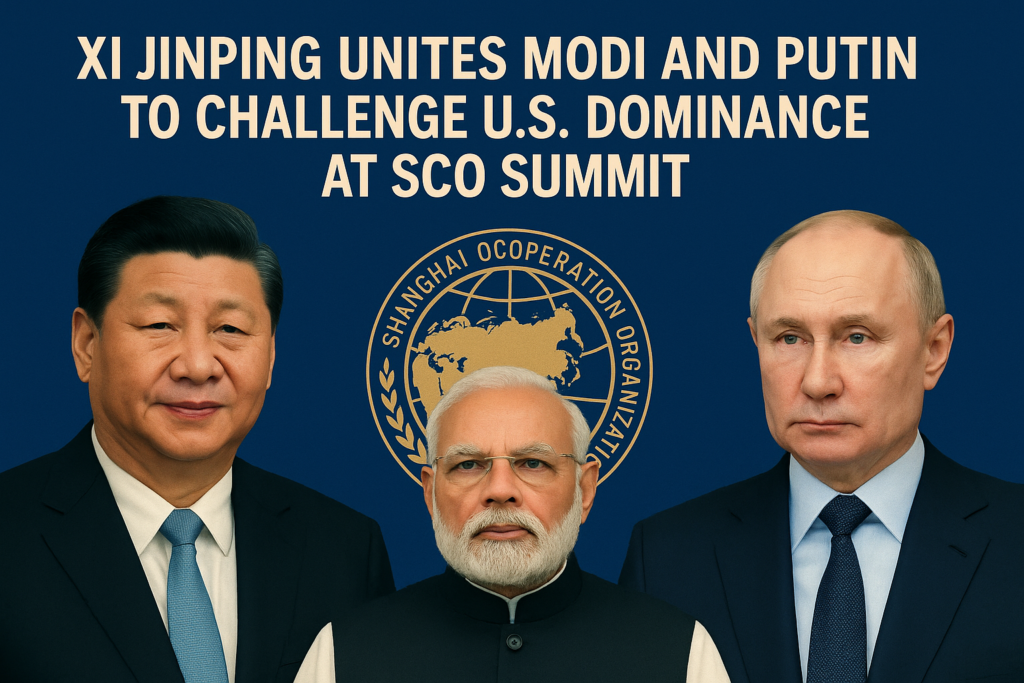Introduction: A New Axis in the Making
The Shanghai Cooperation Organisation (SCO) Summit of 2025 in Tianjin is more than just another diplomatic gathering. It symbolizes the emerging realignment of global power, with Chinese President Xi Jinping, Indian Prime Minister Narendra Modi, and Russian President Vladimir Putin sharing the stage. Together, these three leaders represent not only a massive portion of the world’s population and economy but also a potential strategic coalition that challenges the long-standing dominance of the United States in global affairs.
The summit is unfolding at a moment of geopolitical turbulence. U.S. trade policies, including steep tariffs on partners such as India and China, have rattled global markets and strained Washington’s influence. Meanwhile, the Ukraine war, the Indo-Pacific rivalry, and the race for technological supremacy have deepened divides. Against this backdrop, the SCO has become a stage for Beijing to present itself as the anchor of a multipolar world order—one where U.S. primacy is no longer taken for granted.
Xi Jinping’s Strategic Calculus
President Xi Jinping has long advocated for a “community with a shared future for mankind.” While the phrase may sound lofty, its practical implications are becoming clearer: Xi envisions China as the central node in a global network of power, trade, and security arrangements that do not depend on Washington.
At the SCO Summit, hosting both Putin and Modi provides Xi with multiple wins:
- Geopolitical Legitimacy: By bringing together two nuclear-armed giants—India and Russia—Xi underscores that China can convene and mediate across divides.
- Economic Counterweight: In an era of tariffs and trade wars, the trio can explore alternatives to U.S.-dominated institutions like the WTO, IMF, or World Bank.
- Security Architecture: The SCO is increasingly being framed as not just a regional security bloc but as an Asian counterbalance to NATO.
Xi’s leadership at the summit is, therefore, less about symbolism and more about building enduring mechanisms of influence that outlast any U.S. administration.
Vladimir Putin: Seeking Partners Amid Isolation
For President Vladimir Putin, the SCO summit could not come at a better time. Russia’s war in Ukraine has drawn sanctions from the West, isolating Moscow economically and diplomatically. China has already become Russia’s most vital trade and energy partner, absorbing discounted oil and gas while offering a lifeline to its embattled economy.
By appearing alongside Xi and Modi, Putin projects a narrative of strength—that Russia is far from isolated. Instead, it is part of a powerful Eurasian coalition that can resist Western sanctions and pressure.
Key takeaways from Putin’s perspective:
- Energy Diplomacy: Russia seeks to deepen long-term energy deals with both India and China, providing an economic cushion against Western sanctions.
- Defense Collaboration: Moscow remains a leading defense supplier to both India and China, giving it strategic leverage despite its weakened financial position.
- Political Signaling: By attending the SCO, Putin demonstrates that Russia still commands respect and partnership in global affairs, even if the West refuses to engage.
Narendra Modi: Balancing Act Between Washington and Eurasia
Prime Minister Narendra Modi’s presence is arguably the most intriguing. Unlike Russia and China, India maintains deep ties with the United States—especially in the fields of defense, technology, and investment. The U.S.-India relationship has been cultivated as a counterbalance to China’s rise.
Yet, tariffs and trade friction under Washington’s current administration have complicated this equation. India, facing a 50% levy on its exports to the U.S., has fresh motivation to strengthen alternative economic partnerships. The SCO provides an opportunity for India to:
- Diversify Trade Routes: By connecting with Central Asia, Russia, and China, India can hedge against overdependence on the U.S. market.
- Energy Security: Access to Russian oil and gas at discounted prices remains crucial for India’s rapidly growing economy.
- Regional Stability: Through the SCO, India can engage Pakistan and Afghanistan diplomatically under a broader multilateral umbrella.
Still, Modi’s balancing act remains delicate. While India participates in U.S.-backed groupings such as the Quad, its presence at the SCO sends a strong signal that New Delhi values multipolar engagement over strict alignment.
The Shanghai Cooperation Organisation: More Than a Talk Shop
Founded in 2001, the SCO initially focused on security cooperation in Central Asia. Over time, it has expanded into economic collaboration, infrastructure, energy, and counterterrorism. Today, with eight full members (including India, China, Russia, and Pakistan), four observer states, and nine dialogue partners, it accounts for nearly 40% of the world’s population and over 30% of global GDP.
At the Tianjin summit, discussions are expected to center on:
- Trade Alternatives: Proposals for local currency settlements and reducing dependence on the U.S. dollar in cross-border transactions.
- Infrastructure Corridors: Linking China’s Belt and Road Initiative (BRI) with Russian energy networks and India’s connectivity ambitions.
- Security Cooperation: Joint exercises against terrorism and cyber threats, framed as a counterpoint to NATO.
- Technology and AI: Coordinating policies on artificial intelligence, 5G, and digital governance outside U.S. frameworks.
Challenging U.S. Dominance: A Multipolar World Emerges
The broader implication of this trilateral unity is the erosion of U.S. hegemony. For decades, Washington enjoyed unrivaled dominance in setting global trade rules, defense alliances, and technological standards. That era is under strain.
- Dollar Dependence Weakening
The push for alternative payment mechanisms within the SCO reflects growing unease over the dollar’s dominance and U.S. sanctions power. - Security Without Washington
The SCO may lack NATO’s military integration, but its regular joint drills and intelligence-sharing deepen security coordination outside U.S. influence. - Technology Standards Divide
China is actively pushing its 5G, AI, and digital governance frameworks across Asia and Africa—creating a parallel system to Western standards. - Symbolic Optics
The image of Xi, Putin, and Modi together sends a powerful diplomatic signal: the world’s largest democracy, the world’s most populous authoritarian state, and a sanctioned superpower can cooperate without U.S. mediation.
Tensions Within: Fault Lines Among Friends
While the optics are strong, internal frictions cannot be ignored:
- China-India Border Disputes: Skirmishes along the Himalayan frontier remain a serious obstacle to full trust between Beijing and New Delhi.
- India-Russia Divergence: Russia leans heavily toward China, while India remains cautious about over-reliance on Beijing.
- Economic Asymmetry: China’s economy dwarfs those of Russia and India, raising concerns about unequal benefits from SCO initiatives.
These tensions suggest that while the SCO is a useful counterweight to the U.S., it is far from a seamless alliance.
The U.S. Response
How Washington interprets and responds to this trilateral convergence will shape future geopolitics:
- Tariffs as Leverage or Liability?
If the U.S. continues punitive tariffs, it may inadvertently push India closer to China and Russia. - Quad and Indo-Pacific Alliances
Expect the U.S. to double down on the Quad (with Japan, Australia, and India) and AUKUS as counterweights. - Diplomatic Outreach
Washington may attempt to peel India away from Eurasian partnerships by offering trade incentives or defense deals.
Looking Ahead: A Turning Point for Global Power
The 2025 SCO Summit will likely be remembered as a watershed moment. For the first time in decades, the United States faces a coordinated front of major Eurasian powers working to design an alternative world order.
The critical question is whether this unity will hold. If Xi can keep India engaged despite border disputes, if Putin can maintain relevance despite sanctions, and if Modi can balance ties with both Washington and Eurasia, then the SCO could emerge as a serious geopolitical rival to U.S.-led frameworks.
What is clear is that global power is no longer concentrated in one capital. The multipolar world is not on the horizon—it has arrived.
Conclusion
Xi Jinping’s decision to host both Vladimir Putin and Narendra Modi at the SCO summit marks a bold statement: the days of unipolar U.S. dominance are waning. While challenges and contradictions exist within the Eurasian camp, the symbolism of unity is undeniable. The SCO’s expansion into economic, technological, and security domains signals the birth of a parallel system of global governance.
For Washington, the message is sobering: in an era of trade wars, sanctions, and shifting alliances, America’s primacy is not guaranteed. For Beijing, Moscow, and New Delhi, the summit represents not just a diplomatic event but the launchpad of a new geopolitical era—one in which the rules are no longer written in Washington alone.



